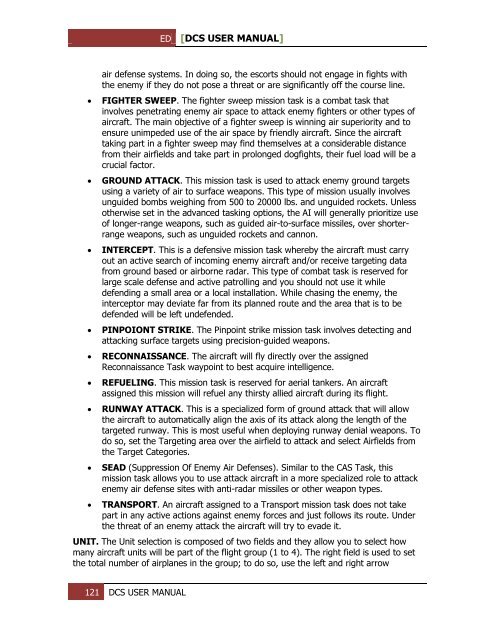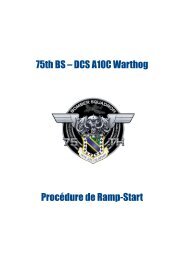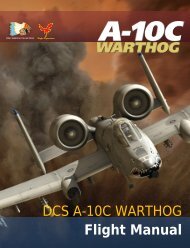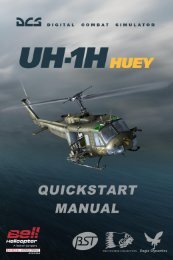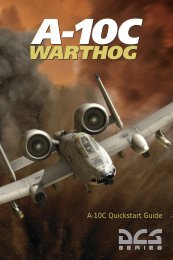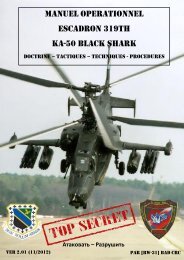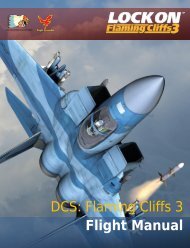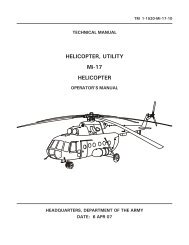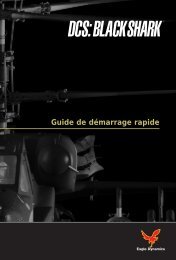You also want an ePaper? Increase the reach of your titles
YUMPU automatically turns print PDFs into web optimized ePapers that Google loves.
ED [<strong>DCS</strong> USER MANUAL]<br />
<br />
<br />
<br />
<br />
<br />
<br />
<br />
<br />
<br />
air defense systems. In doing so, the escorts should not engage in fights with<br />
the enemy if they do not pose a threat or are significantly off the course line.<br />
FIGHTER SWEEP. The fighter sweep mission task is a combat task that<br />
involves penetrating enemy air space to attack enemy fighters or other types of<br />
aircraft. The main objective of a fighter sweep is winning air superiority and to<br />
ensure unimpeded use of the air space by friendly aircraft. Since the aircraft<br />
taking part in a fighter sweep may find themselves at a considerable distance<br />
from their airfields and take part in prolonged dogfights, their fuel load will be a<br />
crucial factor.<br />
GROUND ATTACK. This mission task is used to attack enemy ground targets<br />
using a variety of air to surface weapons. This type of mission usually involves<br />
unguided bombs weighing from 500 to 20000 lbs. and unguided rockets. Unless<br />
otherwise set in the advanced tasking options, the AI will generally prioritize use<br />
of longer-range weapons, such as guided air-to-surface missiles, over shorterrange<br />
weapons, such as unguided rockets and cannon.<br />
INTERCEPT. This is a defensive mission task whereby the aircraft must carry<br />
out an active search of incoming enemy aircraft and/or receive targeting data<br />
from ground based or airborne radar. This type of combat task is reserved for<br />
large scale defense and active patrolling and you should not use it while<br />
defending a small area or a local installation. While chasing the enemy, the<br />
interceptor may deviate far from its planned route and the area that is to be<br />
defended will be left undefended.<br />
PINPOIONT STRIKE. The Pinpoint strike mission task involves detecting and<br />
attacking surface targets using precision-guided weapons.<br />
RECONNAISSANCE. The aircraft will fly directly over the assigned<br />
Reconnaissance Task waypoint to best acquire intelligence.<br />
REFUELING. This mission task is reserved for aerial tankers. An aircraft<br />
assigned this mission will refuel any thirsty allied aircraft during its flight.<br />
RUNWAY ATTACK. This is a specialized form of ground attack that will allow<br />
the aircraft to automatically align the axis of its attack along the length of the<br />
targeted runway. This is most useful when deploying runway denial weapons. To<br />
do so, set the Targeting area over the airfield to attack and select Airfields from<br />
the Target Categories.<br />
SEAD (Suppression Of Enemy Air Defenses). Similar to the CAS Task, this<br />
mission task allows you to use attack aircraft in a more specialized role to attack<br />
enemy air defense sites with anti-radar missiles or other weapon types.<br />
TRANSPORT. An aircraft assigned to a Transport mission task does not take<br />
part in any active actions against enemy forces and just follows its route. Under<br />
the threat of an enemy attack the aircraft will try to evade it.<br />
UNIT. The Unit selection is composed of two fields and they allow you to select how<br />
many aircraft units will be part of the flight group (1 to 4). The right field is used to set<br />
the total number of airplanes in the group; to do so, use the left and right arrow<br />
121 <strong>DCS</strong> USER MANUAL


